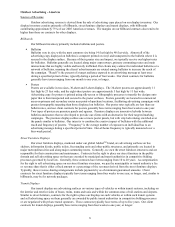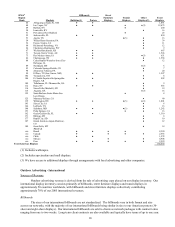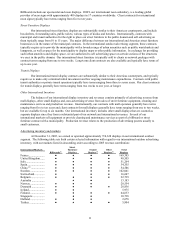iHeartMedia 2005 Annual Report Download - page 17
Download and view the complete annual report
Please find page 17 of the 2005 iHeartMedia annual report below. You can navigate through the pages in the report by either clicking on the pages listed below, or by using the keyword search tool below to find specific information within the annual report.17
permitted to reach, raising the cap from 35% to 45%.
With respect to local radio ownership, the FCC’s June 2003 decision left in place the existing tiered numerical
limits on station ownership in a single market. The FCC, however, completely revised the manner of defining local
radio markets, abandoning the existing definition based on station signal contours in favor of a definition based on
“metro” markets as defined by Arbitron. Under the modified approach, commercial and non-commercial radio stations
licensed to communities within an Arbitron metro market, as well as stations licensed to communities outside the metro
market but considered “home” to that market, are counted as stations in the local radio market for the purposes of
applying the ownership limits. For geographic areas outside defined Arbitron metro markets, the FCC adopted an
interim market definition methodology based on a modified signal contour overlap approach and initiated a further
rulemaking proceeding to determine a permanent market definition methodology for such areas. The further proceeding
is still pending. The FCC grandfathered existing combinations of owned stations that would not comply with the
modified rules. However, the FCC ruled that such noncompliant combinations could not be sold intact except to certain
“eligible entities,” which the agency defined as entities qualifying as a small business consistent with Small Business
Administration standards.
In addition, the FCC’s June 2003 decision ruled for the first time that radio joint sales agreements, or “JSAs”,
by which the licensee of one radio station sells substantially all of the advertising for another licensee’s station in the
same market (but does not provide programming to that station), would be considered attributable to the selling party.
Furthermore, the FCC stated that where the newly attributable status of existing JSAs and LMAs resulted in
combinations of stations that would not comply with the modified rules, termination of such JSAs and LMAs would be
required within two years of the modified rules’ effectiveness.
Numerous parties, including us, appealed the modified ownership rules adopted by the FCC in June 2003.
These appeals were consolidated before the United States Court of Appeals for the Third Circuit. In September 2003,
shortly before the modified rules were scheduled to take effect, that court issued a stay preventing the rules’
implementation pending the court’s decision on appeal. In June 2004, the court issued a decision that upheld the
modified ownership rules in certain respects and remanded them to the FCC for further justification in other respects.
Among other things:
• The court upheld the provision of the modified rules prohibiting common ownership of more than one top-
four ranked television station in a market, but remanded the FCC’s modified numerical limits applicable to
same-market combinations of television stations. It also remanded the FCC’s elimination of the
requirement that, in a transaction that seeks a “failing” or “failed” station waiver of the television duopoly
rule, the parties demonstrate that no out-of-market buyer is willing to purchase the station.
• The court affirmed the FCC’s repeal of the newspaper/broadcast cross-ownership rule, while also
upholding the FCC’s determination to retain some limits on cross-media ownership. However, the court
remanded the FCC’s “cross-media limits” for further explanation, finding that the FCC had failed to
provide a reasoned analysis for the specific limitations it adopted.
• With respect to the modified radio ownership rules, the court affirmed the FCC’s switch to an Arbitron-
based methodology for defining radio markets, its decision to include noncommercial stations when
counting stations in a market, its limitations on transfer of existing combinations of stations that would not
comply with the modified rules, its decision to make JSAs attributable to the selling party, and its decision
to require termination within two years of the rules’ effectiveness of existing JSAs and LMAs that resulted
in non-compliance with the modified radio rules. However, the court determined that the FCC had
insufficiently justified its retention of the existing numerical station caps and remanded the numerical
limits to the FCC for further explanation.
In its June 2004 decision, the court left in place the stay on the FCC’s implementation of the modified media
ownership rules. As a result, the FCC’s rules governing local television ownership and radio/television cross-
ownership, as modified in 1999, remain in effect. However, in September 2004 the court partially lifted its stay on the
modified radio ownership rules, putting into effect the aspects of those rules that establish a new methodology for
defining local radio markets and counting stations within those markets, limit our ability to transfer intact combinations
of stations that do not comply with the new rules, make JSAs attributable, and require us to terminate within two years
(i.e., by September 2006) those of our existing JSAs and LMAs which, because of their newly attributable status, cause
our station combinations in the relevant markets to be non-compliant with the new radio ownership rules. Moreover, in
a market where we own one or more radio stations, we generally cannot enter into a JSA with another radio station if we
could not acquire that station under the modified rules.
























